Etowah Mounds (1250 AD)
So who built Etowah: Hitchitis or Muskogees?
The largest pyramid mound at Etowah is a five-sided pentagon-shaped mound. This mound type is only found in Georgia and one Hitchiti-speaking group, the Okonee, were known for building these types of mounds. (Other mound sites in Georgia with pentagon-shaped mounds include Roods Creek near Kolomoki and the Shoulderbone site. One small pentagon mound was found at Cahokia near St. Louis, Missouri- perhaps a Hitchiti embassy in the great Indian city?)
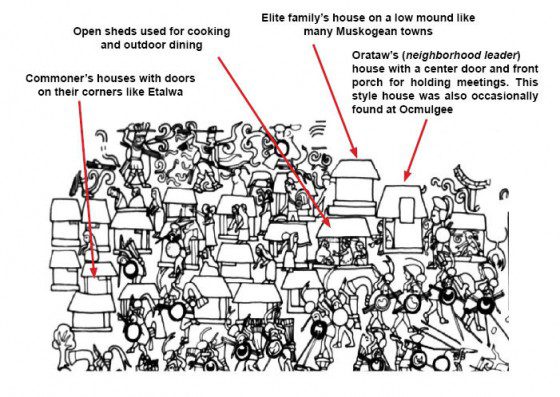 |
| Detail from southwest panel, upper temple of the jaguar, Great Ballcourt at Chichen Itza. This mural shows a village being conquered by the Chontal Maya. The village contains many house types which would show up at Ocmulgee and Etowah Mounds including houses with a corner door. (Image courtesy The Linda Schele Drawing Collection @ FAMSI.org. Labels added by Richard Thorton.) |
Another clue is a house-type archaeologists first discovered at Etowah. This building was noted for having its doorway in the corner of the building not on one of its sides. The Chontal-Maya also constructed their houses with a doorway in the corner of the building. In fact, such houses can still be seen in the Chontalpa region of Mexico today. Furthermore, when the Chontal Maya conquered Chichen Itza they created many murals documenting this conquest. J. Eric Thompson noted in his book Maya History & Religion that these murals also show houses with corner doors. Another researcher has noted that these same murals show many other mound and house types known to be built by the Hitchiti.
(Interestingly, Chichen means “mouth of the well” since in Mayan chi means “mouth” and chen means “well.” Likewise, in Hitchiti chi means “mouth” and chahni means “well” thus chichahni would mean “mouth of the well” in Hitchiti. Coincidentally, the Chontal Maya referred to Chichen Itza as Chichan Itza which means “mouth of the snake of the Itza.”)
So, did the Muskogean invaders build Etowah or was it built by the Hitchiti-speakers first and then taken over by Muskogeans?
The preceding evidence suggests that Etowah was originally constructed by Hitchiti-speaking tribes. Evidence suggests that Mound A, the Great Temple Mound was begun around 1000 AD, around the same time that the Earth Lodge at Ocmulgee Mounds was constructed. The Muskogee-Creek migration legends state the first building they constructed at Ocmulgee after conquering it was a “mound with a central chamber,” i.e., an earth lodge. Thus by 1000 AD Ocmulgee had been conquered and its original Hitchiti inhabitants likely fled north and began construction at Etowah around the same time.
Between 1100-1200 AD (called the Late Etowah Phase) the first two stages of Mound B were constructed. Around this same time, just up the river from Etowah a new village was constructed known today as the Wilbanks site. It featured an earth lodge similar to the one at Ocmulgee Mounds. As was just mentioned, the Muskogee-Creek were the ones constructing earth lodges at this time. Thus it is likely that the Wilbanks site represents the arrival of the Muskogee-Creek into the Etowah area.
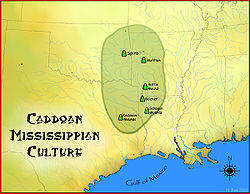 |
| Map of the Caddoan Mississippian Culture area which Spiro was capital. (Image by Herb Roe.) |
Archaeologists note that between 1250 AD – 1300 AD the Etowah valley was depopulated and no mound sites were occuppied. This is called the Early Savannah Period and it is strong evidence that something major, like warfare sparked by the invasion of a new people, was occurring. Interestingly, the Spiro Mounds site mentioned previously experienced a depopulation event in 1250 AD. It appears many of the people moved away at this time although ceremonialism continued at the site. This begs the question, did Etowah simply have a trading relationship with Spiro or was part of its population actually from Spiro? Spiro Mounds was part of the Caddoan Mississippian Culture which covered an area including parts of Oklahoma, Arkansas, Texas, and Northern Louisiana. It was the western most Mississippian culture and the closest to Mexico. Coincidentally, there is a town in northern Louisiana named Tama. One version of the Creek Migration Legend states that one of the four original ethnic groups that were part of the migration “lagged behind” the others. Perhaps Spiro represents this group or perhaps Spiro was the first place these immigrants settled once leaving Mexico. Only further research will reveal the truth.
Starting between 1250 AD- 1325 AD (Early Wilbanks Phase), the Etowah valley was repopulated. But now one archaeologist, William Sears, noted the pottery was so different than the pottery from the preceding phase that it likely “represented an intrusion of foreign people into the region.” At this time the site grew substantially in size and new stages were added to Mound A and Mound B and a new mound was constructed, Mound C- the Funeral Mound. This funeral mound revealed to archaeologists that a powerful elite now lived at Etowah. It is in this mound where the marble statues were found and it is these statues that support a west Mexico origin for this powerful elite. Also, burials in this mound were in log-lined tombs, a practice similar to one in west Mexico. Thus the evidence seems clear that the original Hitchiti builders of Etowah Mounds fled the region as a result of an invasion by Muskogee-Creeks (and possibly their relatives from Spiro.) This explains why there were both Hitchiti features and Muskogee-Creek features at the site.
During this same time period, four other village sites were built near Etowah. From a military point of view this makes perfect sense. If Etowah was the home of the elites and thus the center of power, the outlying villages served as a protective buffer from surprise attacks. Between 1325 AD – 1375 AD, the three large mounds at Etowah were enlarged one last time and reached their final form. This is also when the inhabitants built a raised plaza in front of the Great Temple Mound as well as the defensive moat and pallisade wall around the site. Even within this fortification, both Mounds B and C each were surrounded by their own pallisade walls. (Were the elites also afraid of the people living inside the walls?) Mound construction continued at up to eight sites near Etowah. Clearly Etowah had transformed into a mighty military fortress that could project its power into the surrounding regions. Artifacts suggest that the elite at Etowah had close ties with both Moundville in Alabama and Spiro in Oklahoma. Yet none of this would last long.
What Happened to Etowah?
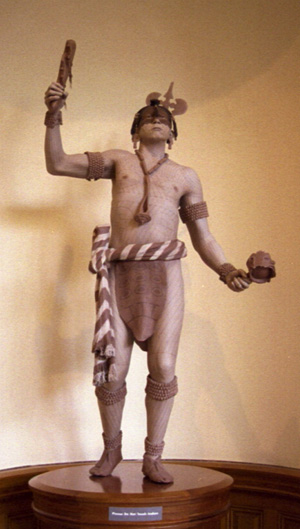 |
| This statue of an Etowah Chief shows him holding a decapitated human head rattle in his left hand and a staff with several scalps in his right. (Georgia State Museum in the Capitol Bldg, Atlanta, GA) |
This statue of an Etowah Chief shows him holding a decapitated human head rattle in his left hand and a staff with several scalps in his right. (Georgia State Museum in the Capitol Bldg, Atlanta, GA)
Warfare seems to always have been a major threat to Mississippian culture. Mississippians required tribute from the lesser tribes in their chiefdoms which undoubtedly inspired much hostility. The strict social classes and hereditary nature of high status political positions inspired even more hostility. Social practices such as human sacrifice, including beheadings, would have invoked further anger. Trade disputes and unfair exchange rates probably caused problems as well. Thus it seems the enormous amount of energy expended in building moats and walls was necessary in order to maintain their particular social order.
(Even today elites choose to live on islands, in walled, gated communities, and in penthouse suites at the top of tall buildings to protect and separate themselves from the perceived “hostile” locals. It seems Etowah’s elites wanted the best of all worlds: to live on a manmade island at the top of the tallest structures in their own gated, private community.)
Interestingly, the Cherokee have an old story relating to a hereditary priestly clan named the Ani-Kutani who held exclusive supervision of all religious ceremonies. In fact, from the legends it seems this clan was not even Cherokee but an outside “missionary” group whose great spiritual power was used to control the tribe. This clan was violently overthrown and massacred when they abused their great power. (Part of these abuses included demanding sexual rights to all females in the village whether they were already married or not.) The Cherokee then returned to a more egalitarian society and all religious ceremonies were conducted by common medicine men.
This oral tradition perhaps offers a glimpse into the fall of Mississippian societies across the southeast and leaves open
View larger map |
| Zoom in to see the individual mounds and other features of the site. Click the blue tabs for more info on each feature. |
an intriguing possibility: did the Mississippians missionize local tribes in order to control them in much the same way the Spanish and other Europeans would do centuries later? Also, did Etowah fall due to an attack by outsiders or was it an internal revolt against similar priestly abuses? (If so, this would be very similar to the fall of Teotihuacan from whence these priests may have originally came.)
After the devastating attack at Etowah around 1375 AD when the pallisade wall was burned, it appears that the Etowah Mounds site was abandoned. The greatest Mississippian center in Georgia was now in ruins and no site in Georgia would ever again rise to the heights it had achieved. (Interestingly, the great Native American metropolis of Cahokia also collapsed around the same time period.) It seems the locals had finally had enough of being dominated by outsiders and struck a mighty blow against them. Interestingly, the invaders had only lasted about 200 years (1200 A.D. – 1375 A.D.) which is very similar to the length of time that Ocmulgee prospered. This suggests that 200 years is the length of time that it takes for an outside power to grow to a point where its ever increasing demands are no longer tolerable to the locals. This same pattern holds true for the British invasion of America. Jamestown was begun in 1607 and by 1808, after two hundred years of warfare and encroachment, the Native American leader Tecumseh attempted to create a pan-Indian movement to seriously resist the ever increasing power of the Americans. The invading force, the Americans, was pondering the question of what to do about the “Indian problem.” Tecumseh failed and Removal was the solution the Americans decided upon regarding the “Indian problem.”
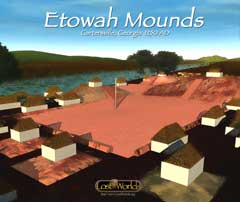 |
| The above art work is available on a variety of gift items in our Gift Shop including t-shirts, mugs, mouse pads, and more. All proceeds help fund future exhibits and videos. Shop Now and Help Support This Site. |
The Creek Migration Legend tells how they were faced with the same question. It tells how after many years of warfare with the local population, the leaders held a council to decide how to deal with the hostile locals. Some wanted to completely annihilate the hostile tribes. Eventually, though, they agreed to follow the path of peace. This may indicate the birth of the Creek Confederacy.
Once again, the archaeological record seems to back up the migration legend. After the fall of Etowah trade goods that once were only found in the graves of elites became more frequently found in the graves of non-elites. Likewise, the mythological symbols associated with the Southeastern Ceremonial Complex faded away. These foreign religious symbols and ideas helped the Mississippian invaders justify their ruling status over the indigenous Woodland peoples. But after the fall of Etowah, it seems a great social revolution occurred and elitist symbols were rejected.
Also artifacts from this period seem to indicate a merging of Woodland and Mississippian cultures. Mississippian pottery would be decorated with Woodland designs. It also appears that the Mississippian/Muscogean practice of hereditary status would be replaced by the Hitchiti/Woodland tradition of earned status.
It also may be during this period that the Mississippians tried to redirect their hostility into less destructive activities such as ballgames. These ballgames, referred to as “the little brother of war,” were ways in which disputes between tribes could be settled without the social disruption brought by warfare. These ballgames were played in the central plazas that were a part of every Mississippian village. These games were rather violent affairs and injuries, even deaths, were common. Participants and spectators often placed large bets on the outcome.
It’s interesting to note that Americans began playing ballgames in earnest after the Civil War which coincidentally featured the burning of Atlanta and a good portion of Georgia. Perhaps our own ballgames served a similar role as a more positive outlet of aggression and a less destructive form of dispute resolution than warfare. Historic Creek ballgames were often played on a field which was 100 yards long and at each end of the field incorporated goal posts constructed from two vertical posts with a horizontal post between them. Sounds very much like a modern American football field (except the game played was more similar to lacrosse).
Etowah Mounds would eventually be reinhabited but never again would it regain the power of its glory days. Yet the Muscogeans would remain one of the most powerful and organized tribal groups in the southeast even into the historic period and contact with Europeans. Even as the Creek Confederacy fell apart and Yuchis, Seminoles, Hitchitis and other original Woodland members went their separate ways, the Muscogeans stayed together and moved to Oklahoma where they created a new nation with a capital named Okmulgee. Interestingly, early observers of the Creeks noted that the Muscogean speakers referred to themselves as “those who stick together” and the other members as “those of a different language.” It would seem that this ability to “stick together” would allow this immigrant group to dominate Georgia for nearly 900 years until another equally unified immigrant group arrived from the British Isles and forced them back towards the west from whence they had originally come. [Read Ancient Civilizations of Georgia: Conclusion]

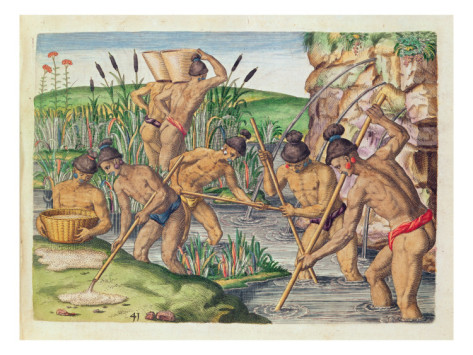

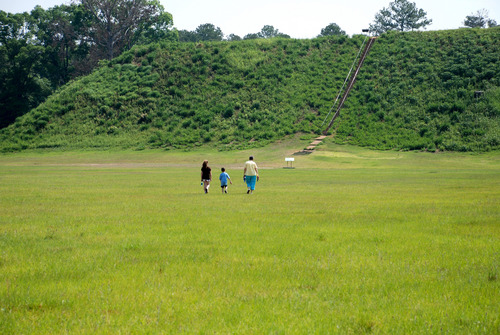
Pingback: Florida Museum of Natural History
Pingback: Looking for information [3 Different artifacts]